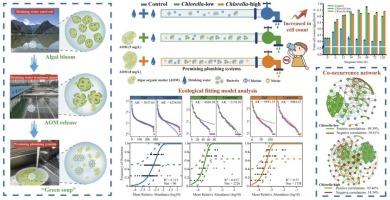Algal organic matter triggers re-assembly of bacterial community in plumbing system
IF 12.2
1区 环境科学与生态学
Q1 ENGINEERING, ENVIRONMENTAL
引用次数: 0
Abstract
Algal bloom outbreaks in upstream drinking water reservoirs inevitably lead to algal organic matter (AOM) pollution in downstream drinking water plants and distribution systems. However, the responses of indoor piped drinking water quality and microbial community to AOM remain to be well studied. In this study, we investigated the effects of low and high concentrations of Chlorella organic matters on pipe-based drinking water. We found that AOM introduced nitrogen and phosphorus contamination into drinking water and promoted massive regeneration of bacteria during stagnation, along with increased bacterial metabolic activity. Compared to the Control group, the utilization capacity of alcohols, acids, esters, and amino acids increased under the influence of AOM. In addition, AOM intrusion reduced the bacterial community diversity in drinking water. The bacterial communities became more saturated, interspecific relationships became more complex, and interspecific competition increased. Bacteria with the ability to denitrification, such as Pseudomonas putida, Sphingobium amiense, Delftia tsuruhatensis, and Acidovorax temperans, were the most abundant. Residual chlorine, ammonium, nitrite, and iron had notable effects on the bacterial community under the influence of AOM. The results help elucidate the response mechanism of microbial community to AOM contamination in indoor drinking water pipes and provide a scientific basis for drinking water safety risk management.

藻类有机物引发管道系统细菌群落的重组
上游饮用水水库的藻华爆发不可避免地导致下游饮用水厂和配水系统的藻质有机物污染。然而,室内管道饮用水水质和微生物群落对AOM的响应仍有待深入研究。在本研究中,我们研究了低浓度和高浓度小球藻有机物对管道饮用水的影响。我们发现,AOM将氮和磷污染引入饮用水,并在停滞期间促进细菌的大量再生,同时增加细菌的代谢活性。与对照组相比,AOM对醇类、酸类、酯类和氨基酸的利用能力有所提高。此外,AOM的入侵降低了饮用水中细菌群落的多样性。细菌群落变得更加饱和,种间关系变得更加复杂,种间竞争加剧。具有反硝化能力的细菌数量最多,如恶臭假单胞菌、氨纶Sphingobium amiense、tsuruhatdelftia tsuruhatensis和temperans Acidovorax。在AOM的影响下,余氯、铵、亚硝酸盐和铁对细菌群落有显著影响。研究结果有助于阐明室内饮用水管道中微生物群落对AOM污染的响应机制,为饮用水安全风险管理提供科学依据。
本文章由计算机程序翻译,如有差异,请以英文原文为准。
求助全文
约1分钟内获得全文
求助全文
来源期刊

Journal of Hazardous Materials
工程技术-工程:环境
CiteScore
25.40
自引率
5.90%
发文量
3059
审稿时长
58 days
期刊介绍:
The Journal of Hazardous Materials serves as a global platform for promoting cutting-edge research in the field of Environmental Science and Engineering. Our publication features a wide range of articles, including full-length research papers, review articles, and perspectives, with the aim of enhancing our understanding of the dangers and risks associated with various materials concerning public health and the environment. It is important to note that the term "environmental contaminants" refers specifically to substances that pose hazardous effects through contamination, while excluding those that do not have such impacts on the environment or human health. Moreover, we emphasize the distinction between wastes and hazardous materials in order to provide further clarity on the scope of the journal. We have a keen interest in exploring specific compounds and microbial agents that have adverse effects on the environment.
 求助内容:
求助内容: 应助结果提醒方式:
应助结果提醒方式:


